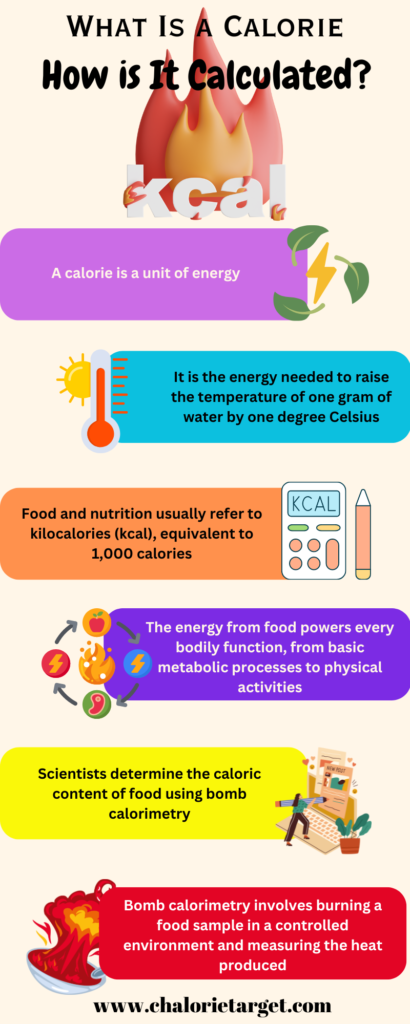Understanding the energy value of foods is fundamental for anyone invested in health, nutrition, and fitness. This measure, often expressed in calories, is significant in guiding our dietary choices, managing weight, and optimizing performance.
But how is the energy value of the foods we consume determined, and why is it so crucial for our daily health and nutrition?
1. Understanding the Basics: What Is a Calorie and How Is It Calculated?

A calorie is a unit of energy. Specifically, it is the energy required to raise the temperature of one gram of water by one degree Celsius. Food and nutrition usually refer to kilocalories (kcal), equivalent to 1,000 calories.
The energy we derive from food is essential for powering every bodily function, from basic metabolic processes to rigorous physical activities.
To determine the caloric content of food, scientists use bomb calorimetry. This technique involves burning a food sample in a controlled environment and measuring the heat produced, which corresponds to the food’s energy value.
However, due to its complexity and cost, this method is not commonly used for everyday food labelling.
Read More: Are Liquid Calories the Same as Food Calories?
2. Factors Influencing Energy Value: Macronutrient Composition and Metabolic Differences
The energy value of a food item is influenced by its macronutrient composition—precisely, the amounts of carbohydrates, proteins, and fats it contains. Here’s a quick breakdown of how each macronutrient contributes to the overall energy value:
- Carbohydrates: Provide 4 kcal per gram
- Proteins: Provide 4 kcal per gram
- Fats: Provide 9 kcal per gram
It’s important to note that not all calories are created equal. As Nutritionist John Smith states, “Not all calories are equal. The source of calories matters for health and weight management.” For example, calories from whole foods like vegetables and lean meats are generally more beneficial than processed foods.
Metabolic differences also play a role. Age, gender, muscle mass, and metabolic rate can affect how efficiently our bodies convert food into usable energy.
3. The Science Behind Determining Energy Value: Atwater System and Its Limitations

The Atwater system is a commonly used method for estimating the energy value of foods. Developed by American chemist Wilbur Olin Atwater in the late 19th century, this system assigns specific caloric values to macronutrients:
- Carbohydrates: 4 kcal/g
- Proteins: 4 kcal/g
- Fats: 9 kcal/g
- Alcohol: 7 kcal/g
While useful, the Atwater system has its limitations. It doesn’t account for the thermic effect of food (the energy expenditure required for digestion, absorption, and assimilation), nor does it consider the varying bioavailability of nutrients in different foods.
As Prof. Alex Kim advises, “While the Atwater system is a useful tool, it has limitations in accurately reflecting the true energy value of all foods.”
4. Practical Applications: Tips for Managing Energy Intake and Output
Understanding the energy value of foods can help you make informed decisions about your diet. Here are some practical tips for managing your energy intake and output:
- Track Your Food Intake: Use apps or food diaries to record your foods and beverages. Include portion sizes and preparation methods for accuracy.
- Focus on Nutrient-Dense Foods: Choose foods that provide essential nutrients without excessive calories. Examples include fruits, vegetables, whole grains, and lean proteins.
- Balance Your Meals: Aim for a mix of carbohydrates, proteins, and fats in each meal to ensure a balanced intake of nutrients and sustained energy levels.
- Pay Attention to Portion Sizes: Be mindful of serving sizes to avoid overeating, especially with high-calorie foods.
- Consider Your Activity Level: Adjust your caloric intake based on your physical activity level to maintain or achieve your desired weight.
Read More: What’s the Difference Between Carbs and Calories? Understanding the Essential Differences
5. Case Studies and Examples of High and Low Energy Value Foods
High Energy Value Foods:
- Nuts and Seeds: Rich in healthy fats, providing a high energy value.
- Avocado: A nutrient-dense fruit with a high fat content.
- Oils: Such as olive and coconut oil, are calorie-dense energy sources.
Low Energy Value Foods:
- Leafy Greens: Such as spinach and kale are low in calories but rich in nutrients.
- Berries: Provide a good amount of vitamins and fibre with relatively few calories.
- Broth-Based Soups: Generally low in calories and can be filling.
6. What is the difference between calories and kcal?
In nutrition and energy measurement, “calories” and “kilocalories” (kcal) are often used interchangeably, but it’s essential to understand their distinctions. A kilocalorie (kcal), or large calorie, equals 1,000 small calories and is commonly used in dietary contexts.
In everyday language, caloric content on food labels refers to kilocalories. For example, a serving size with 200 “calories” means 200 kilocalories or 200,000 small calories. This distinction is crucial for accurate dietary planning and understanding food labels.
Kilocalories help nutritionists and dietitians track energy intake and create dietary plans. Knowing the difference ensures clarity about energy consumption and helps optimize nutritional choices based on individual needs. Remember, 1 kcal equals 1,000 cal, which is the standard in dietary guidelines.
Accurate food labelling and consumer education on these terms are essential. Misunderstandings can lead to incorrect energy intake estimates, which can impact health goals. An informed approach to reading food labels is key to maintaining a balanced diet.
Read More: What is a Calorie in Chemistry?
7. Why are food calories not based on the weight of the food?
While one might assume that the calorie content of food would be directly proportional to its weight, this is not the case. The energy value of food depends more on its macronutrient composition than its weight.
Different macronutrients—carbohydrates, proteins, and fats—have varying caloric densities, meaning the exact weight of each macronutrient will provide various amounts of energy. Therefore, foods with higher fat content, for example, will have more calories per gram than foods rich in proteins or carbohydrates.
Additionally, the bioavailability of nutrients and the thermic effect of food also influence the actual energy derived from food, further complicating the relationship between weight and caloric content.
- The calorie content isn’t proportional to weight.
- Macronutrient composition influences energy value.
- Different macronutrients have varying caloric densities.
- High fat content boosts calories per gram.
- Nutrient bioavailability and thermic effect impact actual energy.
8. Future Trends in Measuring and Understanding Energy Value
As technology advances, new methods for measuring and understanding the energy value of foods are emerging. These include more precise metabolic tracking devices and advanced software that can analyze nutrient bioavailability more accurately.
Such innovations could eventually replace traditional methods like the Atwater system, offering more personalized and accurate dietary recommendations.
9. Conclusion
Whether you’re a nutrition enthusiast, a health-conscious individual, or part of the fitness community, knowing how to manage your energy intake and output is vital to achieving optimal well-being.
Remember, focus not just on the quantity of calories but also their quality; dietitian Emma Lee suggests, “For most people, focusing on the quality of calories over quantity is key in a sustainable approach to health.”
Stay updated with the latest trends and tools to ensure you’re always making informed decisions about your diet. And if you’re looking for a reliable way to track your food and energy intake, numerous apps and devices can assist you in your journey toward better health.
